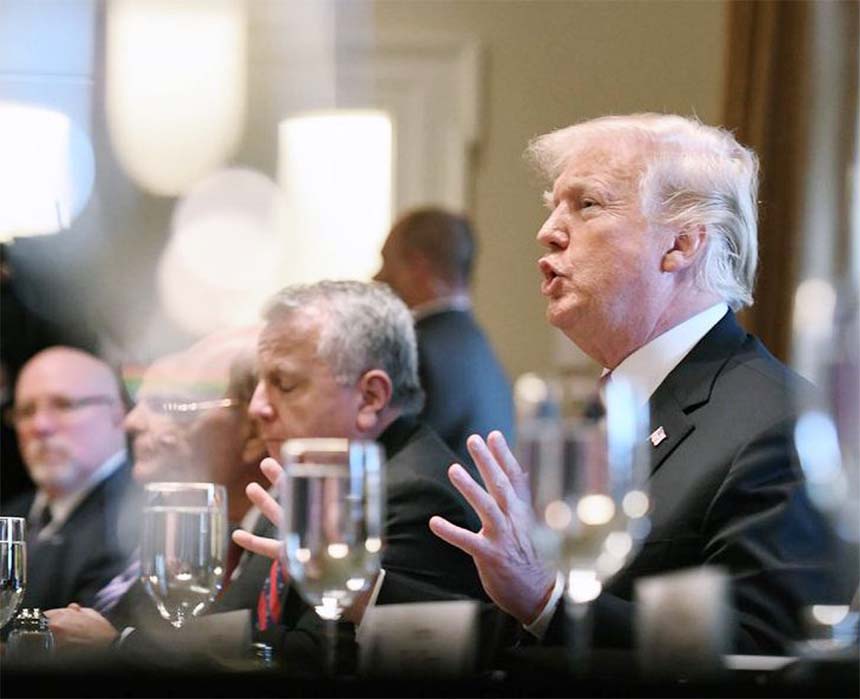
Reuters, Washington :
President Donald Trump sharpened his anti-immigration rhetoric on Tuesday, saying he wants to deploy U.S. military forces to the Mexican border to stop illegal immigrants until his long-promised wall is built and “proper security” is in place.
His comments, following a threat to halt foreign aid to Honduras and other countries unless they stopped a “caravan” of Central Americans headed to the United States, immediately raised questions about troop deployment on U.S. soil.
Trump called using the military at the southern border “a big step.” He met on Tuesday with U.S. Defense Secretary James Mattis and others to discuss the idea.
“Until we can have a wall and proper security we’re going to be guarding our border with the military,” Trump told reporters at the White House, lamenting what he called “horrible” U.S. laws that left the southern border poorly protected.
After 14 months in office, Trump still hammers regularly on an anti-immigration theme that helped to energize conservative Republican voters who helped him win the presidency in the 2016 election. Trump took a hard line on illegal immigration during the campaign and has also sought to curtail legal immigration.
Trump’s efforts have failed to produce a deal on immigration or funding a border wall in the Republican-led Congress and no major legislation was expected before November’s congressional elections.
Trump gave no details on the size or mission of a military border deployment. The Posse Comitatus Act, a federal law, prohibits using the military for civilian law enforcement duties on U.S. soil unless authorized by Congress.
But the military can provide support services to law enforcement and has done so on occasion since the 1980s.
Under Republican President George W. Bush, National Guard forces were used between 2006 and 2008 for border-related intelligence analysis, but had no direct law enforcement role.
In 2010, President Barack Obama sent some National Guard troops to the U.S.-Mexican border to provide intelligence, surveillance and reconnaissance support to U.S. Border Patrol agents.
Some specific statutes authorize the president to deploy troops within the United States for riot control or relief efforts after natural disasters, such as hurricanes and floods.
President Donald Trump sharpened his anti-immigration rhetoric on Tuesday, saying he wants to deploy U.S. military forces to the Mexican border to stop illegal immigrants until his long-promised wall is built and “proper security” is in place.
His comments, following a threat to halt foreign aid to Honduras and other countries unless they stopped a “caravan” of Central Americans headed to the United States, immediately raised questions about troop deployment on U.S. soil.
Trump called using the military at the southern border “a big step.” He met on Tuesday with U.S. Defense Secretary James Mattis and others to discuss the idea.
“Until we can have a wall and proper security we’re going to be guarding our border with the military,” Trump told reporters at the White House, lamenting what he called “horrible” U.S. laws that left the southern border poorly protected.
After 14 months in office, Trump still hammers regularly on an anti-immigration theme that helped to energize conservative Republican voters who helped him win the presidency in the 2016 election. Trump took a hard line on illegal immigration during the campaign and has also sought to curtail legal immigration.
Trump’s efforts have failed to produce a deal on immigration or funding a border wall in the Republican-led Congress and no major legislation was expected before November’s congressional elections.
Trump gave no details on the size or mission of a military border deployment. The Posse Comitatus Act, a federal law, prohibits using the military for civilian law enforcement duties on U.S. soil unless authorized by Congress.
But the military can provide support services to law enforcement and has done so on occasion since the 1980s.
Under Republican President George W. Bush, National Guard forces were used between 2006 and 2008 for border-related intelligence analysis, but had no direct law enforcement role.
In 2010, President Barack Obama sent some National Guard troops to the U.S.-Mexican border to provide intelligence, surveillance and reconnaissance support to U.S. Border Patrol agents.
Some specific statutes authorize the president to deploy troops within the United States for riot control or relief efforts after natural disasters, such as hurricanes and floods.

